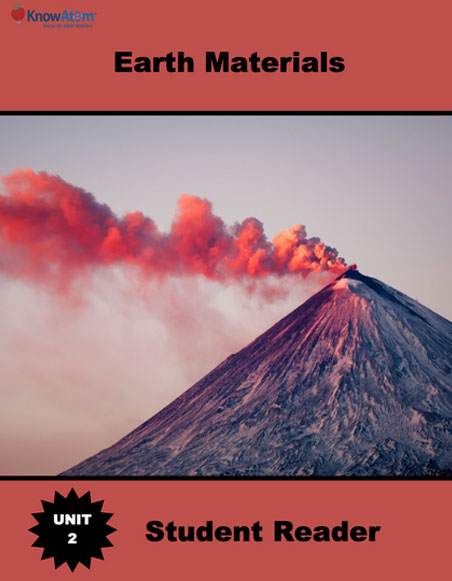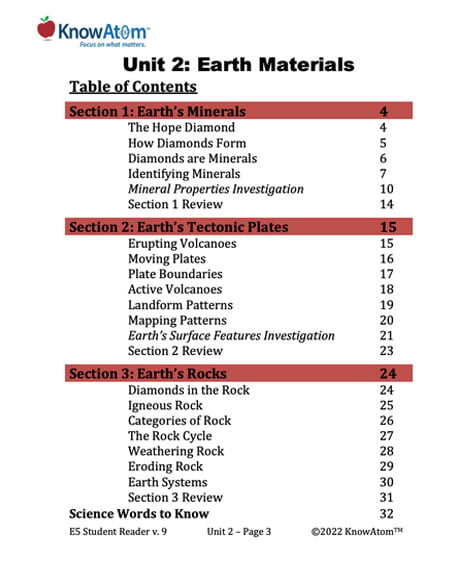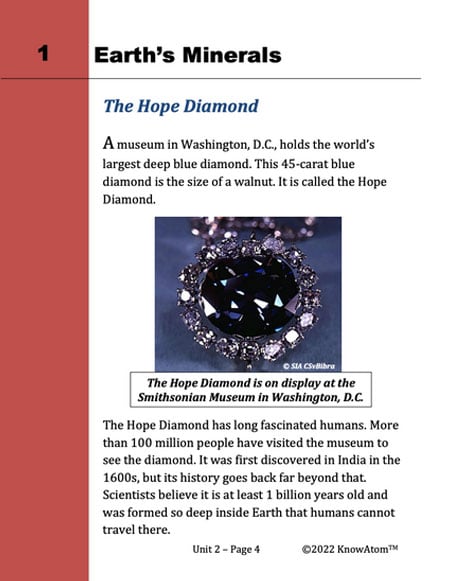Science background provides teachers with more in-depth information about the phenomena students explore in this unit. Here is an excerpt from the science background information on weathering rocks.
The matter that makes up rocks is never created or destroyed. Instead, it is constantly changing from processes that happen on Earth’s surface and deep within Earth’s interior. Heat and pressure reshape and re-form one kind of rock into different kinds over time. The processes that form, break down, and re-form rock from one category to another are called the rock cycle.
For example, rocks on Earth’s surface break down into sediment. That sediment can collect in layers. Over time, heat and pressure can compress the layers of sediment into new sedimentary rock.
Or the sediment can get pushed deep into Earth’s crust by the movement of tectonic plates. There, it can undergo chemical reactions that change its properties, turning it into metamorphic rock. Eventually, any rock pushed deep into Earth’s interior will melt into magma. If magma reaches the surface, it will cool and harden into rock again.
Over time, wind and water weather all rocks on Earth’s surface. Weathering is the breakdown of rock into small pieces from exposure to wind, water, changes in temperature, and/or biological forces. For example, over millions of years, the diamond inside kimberlite rock can become exposed when the rock is weathered. Wind and water weather rock because they are both forces that can cause substances such as rocks and other sediment to move and rub against one another. There are two kinds of weathering: chemical and mechanical weathering.
Mechanical weathering takes place when rocks are broken down by physical force without any change in their chemical structure. Mechanical weathering is a physical change because it does not affect the chemical structure of a substance. Whenever rocks and sediment grind against each other, they mechanically weather surfaces. This kind of weathering is called abrasion.
Chemical weathering occurs when chemical reactions change the composition of rocks, rearranging the atoms or molecules into new substances with different properties. Chemical weathering generally occurs gradually over time.
Erosion is the transport of sediment by wind, water, or gravity. Some diamond deposits are caused by erosion, as kimberlite rocks containing diamonds are eroded, carried to new locations by wind, water, or gravity. Scientists have found evidence of this with kimberlite rocks containing diamonds in areas far away from volcanoes.
Weathering and erosion usually work together. For example, wind and water carry pieces of sediment that grind against rock and wear it away. Water can also seep into cracks between rocky particles and expand, making cracks larger. Over time, the rock wears down from the inside and crumbles into sediment.
As water moves over rock, two of Earth’s systems interact together (the hydrosphere and the geosphere). A system is a set of connected, interacting parts that form a more complex whole. Earth has so many different parts that scientists study Earth’s four systems— the hydrosphere, the geosphere, the atmosphere, and the biosphere—to understand the interactions among the different parts. Each system is made up of parts that influence one another. At the same time, each system interacts with the other systems.
For example, all of the water found on Earth makes up an Earth system called the hydrosphere. The rocks are part of a system called the geosphere. The geosphere is made up of Earth’s landforms, including rocks and soil. As water moves over Earth’s surface, it shapes the geosphere as it weathers and erodes the rocks and soil it passes over. When wind weathers and erodes rock, another system is at work. The atmosphere is the Earth system made up of a mixture of gasses, dust, water vapor, and other molecules above Earth’s crust. Earth’s gravity holds the atmosphere in place.
Another Earth system is called the biosphere. This system includes all living things on Earth. Living things depend on all of the other systems for survival. At the same time, living things impact their surroundings as they breathe air, drink water, and live on Earth’s surface.








